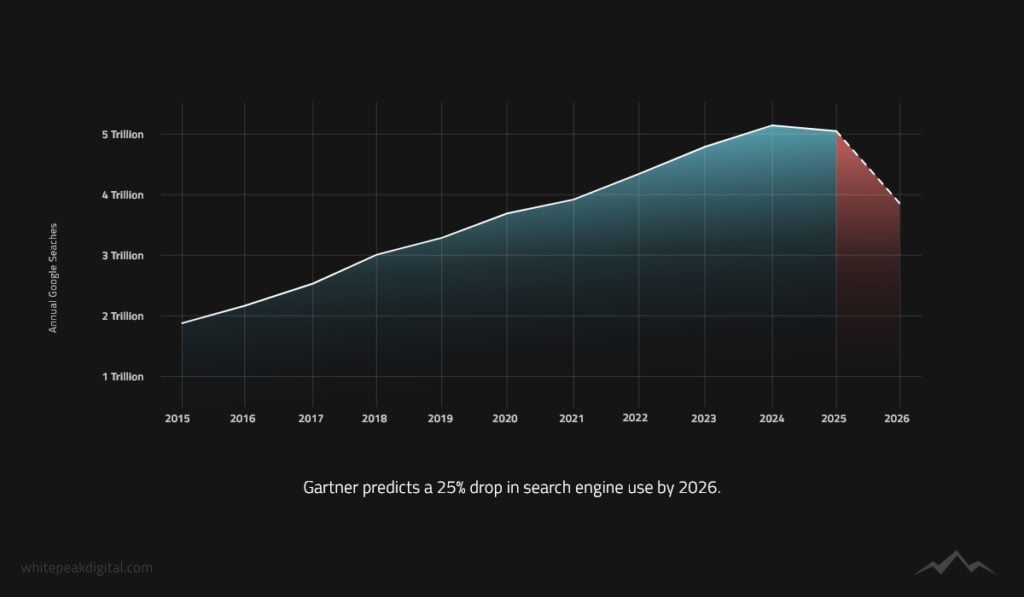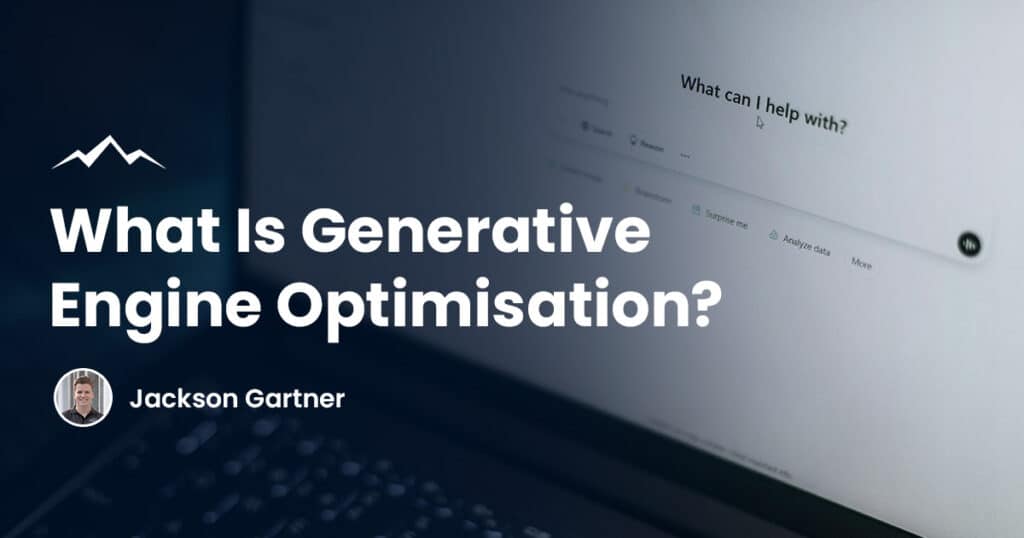The way people search online is changing fast.
AI-powered search engines are rewriting the rules, shifting focus away from long lists of blue links to smart, conversational responses. This evolution calls for a new strategy: Generative Engine Optimisation.
So, what is generative engine optimisation?
In short, GEO helps your content appear in answers created by AI-driven platforms like ChatGPT, Perplexity, Gemini and Google’s AI Overviews.
Rather than competing for traditional search rankings, you’re positioning your brand as the go-to source that AI draws from when users ask questions.
As generative engines grow in popularity, the need for content that AI can easily understand, trust and feature becomes critical. Unlike traditional search engines, these platforms prioritise fluency, clarity, relevance and authority.
In this article, you’ll learn what GEO is, how it differs from traditional SEO and why it’s essential for staying visible in the new search landscape. Whether you’re a business owner, digital marketer or content strategist, this is your opportunity to stay ahead and adapt your digital presence for the future of search.
Understanding Generative Engine Optimisation
Generative engine optimisation is the process of tailoring your digital content to be featured in AI-generated responses on platforms powered by generative AI.
These AI platforms include tools like ChatGPT and Google’s AI Overview, which answer user queries with full responses instead of directing users to a list of websites.
Unlike traditional search engines, which return a list of ranked website links, generative engines analyse multiple sources to create a single, cohesive answer. GEO ensures your content is part of the data these engines rely on to build those responses.
Instead of simply aiming for first-page placement, GEO focuses on content fluency, clarity and context so that AI platforms can recognise and prioritise it. These engines reward well-structured, helpful content that directly addresses the user’s query with depth and accuracy.
GEO is about more than adding keywords or writing for algorithms. It’s about creating content that AI understands, trusts and chooses to include in its generated answers.
This requires a different mindset, one that prioritises natural language, expert insights and a clear understanding of user intent.
At its core, GEO bridges the gap between what users are asking and how AI interprets your content as a credible solution. If your content lacks context, clarity or authority, it’s unlikely to make it into a generative response.
To compete in this space, your content must go beyond surface-level optimisation. It needs to demonstrate subject matter expertise, use well-organised structure and offer valuable information that aligns with the user’s goals.

GEO vs Traditional SEO
Both GEO and traditional SEO aim to improve your content’s visibility online, but they do it in very different ways.
Understanding how these approaches overlap and diverge is key to building an organic digital marketing strategy that works across both standard search engines and AI-driven platforms.
Traditional SEO focuses on optimising web pages to rank in search engine results pages (SERPs). It relies heavily on elements like keyword placement, meta tags, backlinks and structured content to climb the rankings. Success is often measured by page position and organic search traffic.
GEO is built for generative engines. These AI systems generate a single response to a search query, pulling from a wide range of online content to provide quick, context-rich answers. Your goal with GEO is to create content that is selected by AI to help form those answers.
Key Differences Between GEO & SEO
- How content is used: Traditional SEO gets users to click through to your site. GEO aims to embed your insights directly into the AI’s response.
- How relevance is measured: Traditional SEO focuses on keyword optimisation and page structure. GEO looks at contextual relevance, clarity and how fluently your content reads in natural language.
- How visibility is achieved: SEO targets rankings on SERPs. GEO targets placement within generated content, often without a traditional backlink to your website at all.
Despite their differences, GEO and SEO share common foundations. Both reward high quality content, meaningful structure and clear alignment with user intent. They also both require regular updates to content to remain aligned with evolving algorithms and user preferences.
By combining the strengths of SEO and GEO, you can expand your digital reach and improve your visibility in both traditional and AI-powered search environments.
Why GEO Matters Right Now
Generative engine optimisation is quickly becoming one of the most important strategies in digital marketing. As more people turn to AI-powered platforms for fast, conversational answers, traditional search methods are starting to fall behind.
AI-driven search tools are changing how users interact with information online. Instead of scanning through pages of links, users now expect direct, relevant responses that feel like a real conversation.
This shift in behaviour means businesses must adapt their website content strategies. Relying on traditional SEO alone could soon mean missing out on huge volumes of potential traffic.
Gartner predicts a 25% drop in search engine use by 2026 as users migrate towards AI search experiences.
At the same time, trust in generative engines continues to grow. Millions of users already rely on these platforms daily for everything from product research to industry insights.
If you’re not optimising for generative engines now, you’re missing the chance to shape how your brand appears in these AI-generated responses. Brands that adapt early have a real opportunity to dominate in this new space.

How Generative AI Search Engines Work
To succeed with generative engine optimisation, you need to understand how AI-powered search engines operate.
These platforms don’t behave like traditional search engines. They don’t just index content and match keywords. Here’s a breakdown of how they generate full responses by synthesising information from multiple sources:
1. Data Gathering
AI engines collect vast amounts of data from across the internet, including web pages, forums, social media and more.
They use this data to build a knowledge base they can reference when answering queries.
2. Natural Language Processing
At the core of generative engines is natural language processing (NLP). This technology helps AI interpret user queries in context.
Rather than matching keywords alone, it analyses the meaning behind the words to understand intent.
3. Response Generation
When someone enters a query, the AI draws from its knowledge base to create a fluent, structured response.
It’s not pulling from one source. It’s merging relevant information from many different places into a single answer.
4. Prioritisation of Sources
Not all content is treated equally. AI engines prioritise high quality, clearly written and authoritative content.
If your content meets these standards, it has a higher chance of being referenced in AI-generated results.
5. Continuous Learning
Generative engines are designed to learn and improve over time. They adapt based on feedback, user behaviour and new content being published across the web.
This is where GEO becomes essential. You’re not just optimising for machines crawling and indexing your site. You’re creating content that AI understands, trusts and wants to include in its responses.
Best GEO Strategies For Visibility
To improve your visibility in generative search results, your content must be easy for AI engines to interpret, prioritise and present.
Start by reviewing your use of structured data. Adding schema markup helps AI engines understand the context of your content.
Marking up articles, reviews and FAQs signals to search tools what your content covers and how it should be interpreted.
When it comes to keywords, generative search engines reward semantic relevance. This means your content should naturally include relevant terms, related phrases and entity references that reflect the full context of a topic.
Understanding user intent is central to this. Think about what someone truly wants to learn, solve or achieve when they search, and write your content with that goal in mind.
Answering questions directly helps as well. Starting a paragraph with a clear, direct response followed by supporting detail makes it easier for AI to extract and feature your content. Generative engines prioritise content that gets to the point quickly.
Finally, your content should carry authority. Link to trustworthy sources, include relevant statistics and offer expert commentary where possible. AI tools are more likely to trust and prioritise content that shows a high level of accuracy and insight.
Pro tip: Learn about EEAT and how it helps you maximise your content authority.

How To Create GEO Content
Creating content for generative engine optimisation isn’t just about what you say, it’s about how you say it. Your writing must be clear, helpful and structured in a way that AI can easily understand and reuse.
Unlike SEO, which often focuses on appeasing algorithms through keyword placement, GEO is built around satisfying real human queries and AI interpretation at the same time.
The most important starting point is clarity. Every paragraph should serve a purpose and answer a specific question or need. Keep your language natural and avoid writing for search engines.
AI engines value fluency because they want to produce answers that sound human. Clunky phrasing, awkward transitions or overly technical language can reduce your chances of being included in generative search results.
You should also avoid filler. Every word matters when AI scans your content. Don’t use long-winded introductions or generic statements that say very little.
Instead, focus on depth and relevance. Aim to provide real insight or unique angles that might help a user solve a problem or better understand a topic.
The structure of your content is just as important as the words themselves. Use H2 and H3 headings to group content logically and make sure your most important points appear near the top of each section.
Generative engines often prioritise information found early in the copy, especially if it answers a question directly.
Visual and interactive elements such as images, tables or bulleted summaries can also help. These features make your page more scannable and enhance engagement for both AI and human readers.
If your content is easier to navigate and offers multiple content types, it’s more likely to be featured in AI search responses.
Bullet points are particularly useful. When used thoughtfully, they break down complex ideas into manageable pieces. They also give AI engines a clear format to extract key details and repurpose them in their own response structure.
How To Increase Brand Authority In AI Search
Authority has always played a role in SEO, but in the world of generative engine optimisation, it’s even more critical.
AI-powered search engines don’t just pull facts at random. They prioritise information from sources they recognise as trustworthy and authoritative.
To become one of those sources, your brand needs a consistent and credible presence across the web.
This starts with the fundamentals: publishing well-researched content, citing reputable sources and offering original insights.
The more useful and accurate your content is, the more likely AI engines are to reference it in their responses.
1. Consistency Across Platforms
The details about your business (contact information, services and location) should match across your website, social media and third-party platforms.
Mixed signals confuse users and AI systems alike. If your brand identity feels scattered, it’s harder for AI to verify your reliability.
2. Backlinks Still Matter
High-quality backlinks are still valuable in GEO.
Being linked to from trusted websites increases the credibility of your content. Focus on earning links through useful resources, guest articles or digital PR efforts.
A strong internal linking strategy also reinforces the structure and relationships between your key pages.
3. User Engagement Signals
AI engines also pay attention to what people are saying on review sites, social platforms and community forums.
Encouraging happy customers to leave reviews in public places online helps build social proof. These real-world signals help AI determine which brands to trust.
4. Build Credibility Over Time
Brand authority doesn’t happen overnight, but it builds with consistency. Stay helpful, stay reliable and make sure your content reflects real-world experience.
Over time, AI engines begin to recognise your brand as a dependable source when assembling answers to user queries.

Tracking GEO Performance & Rankings
Once you’ve started applying generative engine optimisation strategies, it’s essential to measure their impact. Unlike traditional SEO, which relies heavily on keyword rankings and search engine traffic, GEO requires a more nuanced approach.
Understanding how your content is being discovered, referenced and used by AI engines will help you adjust and improve your strategy over time.
Referral Traffic from AI Platforms
Some AI platforms, like Google AI Overviews and ChatGPT, attribute their sources directly. These citations often appear as part of the generated response and link back to the original content.
While not every engine provides attribution, the ones that do offer a valuable opportunity to track referral traffic from these placements.
Keep a close eye on your analytics tools for new referral sources that weren’t part of your typical organic traffic. Tools like Google Analytics can help track these signals and offer a clearer picture of where your visibility is growing.
Search Visibility Beyond SERPs
Standard SEO platforms such as Google Search Console or Semrush still have a role in GEO, but they won’t tell the full story.
Tip: Semrush has recently announced a new ChatGPT Positioning Tracking Tool that is currently in Beta on their platform, you can find out more about that here.
With GEO, much of your content may appear in AI summary boxes, conversational responses or overview panels which are areas not easily tracked with traditional SEO reporting.
Because of this, it’s important to use manual checks and AI platform testing. Run your most important queries on tools like ChatGPT and Gemini to see if your content is being summarised or referenced.
While time-consuming, these checks offer real insight into how AI views and utilises your pages, which is key to refining your optimisation efforts.
Look for Content Reuse Signals
Even when AI engines don’t cite your content directly, they may still use the information within it. This includes statistics, definitions or phrasing that closely resembles what you’ve published.
These are known as “soft signals” and while they’re more difficult to track, they offer important insight into your reach and influence.
To spot reuse, search for specific snippets or phrasing from your content across generative platforms. If you find similar language in responses, it’s likely your page contributed to that output.
If certain types of content are consistently being paraphrased or partially reused, consider expanding them into a more detailed guide or resource.
Engagement & Dwell Time
User engagement metrics like average time on page, bounce rate and scroll depth are valuable signals in both traditional SEO and GEO.
AI systems often monitor how users interact with content across the web and pages that hold attention are generally seen as more helpful and trustworthy.
Review this data in your website analytics platform and identify which pages are performing best.
Are readers scrolling through the entire page? Are they clicking internal links or taking action?
These behaviours suggest your content is answering their needs and those are the signals AI is trained to value.
Pro tip: Consider using heatmaps or session recordings to observe real user behaviour. Tools like Hotjar or Microsoft Clarity can reveal if users are getting stuck, bouncing early or missing important CTAs.
These insights not only help with conversion optimisation, but also with improving the fluency and value of your content for GEO purposes.
Integrating GEO Into Your Digital Marketing Strategy
Generative engine optimisation isn’t going to replace SEO anytime soon but it’s definitely going to enhance it.
When used together, GEO and traditional SEO can create a powerful foundation for long-term visibility across both classic search engines and AI platforms.
Use SEO as the Baseline
Without a solid technical SEO foundation, AI engines may struggle to crawl and understand your site.
Fast load times, mobile optimisation, clean code, consistent internal links and structured metadata all contribute to better performance in both search formats.
Your SEO efforts help ensure your content is discoverable and indexable. This is still essential, even when the goal is to appear in a conversational AI response.
Create Content That Works Across Both
GEO and SEO can be addressed in the same content but the format needs to serve both users and machines.
A blog post targeting a specific search term can be structured to rank well in Google while also providing the clarity and authority needed for generative platforms.
This means combining natural language with keyword strategy, using descriptive headings and answering user questions directly and early.
Rethink Your Keyword Research Process
Focus on how users phrase real questions and what kind of information they expect.
Look at forums, social media and even AI-generated answers to see the patterns and structure used in high-performing content.
You’ll need to optimise for keywords and conversational intent which is the context behind what users are actually asking and how they want the answer to be delivered.
Maintain Your Brand Voice
AI engines favour content that reads naturally and aligns with user expectations but that doesn’t mean everything needs to be technical or overly formal.
Keep your tone consistent with your brand. Whether your audience prefers a straightforward explanation or a more personable voice, make sure your content reflects that throughout.
A clear and consistent tone not only builds trust with users, but also helps generative engines recognise and reuse your content accurately.

The Future Of Search With GEO
AI-powered search is no longer a trend but a complete shift in how people interact with the internet and online content.
Platforms like ChatGPT, Google’s AI Overviews and Perplexity are already changing the way users find answers, make decisions and discover new brands. If your content isn’t prepared for this new landscape, your website traffic will suffer.
Pro tip: If you’re looking to stay ahead of the curve with help from a local team that are Generative Search Optimisation specialists, reach out to our Brisbane SEO team today.
Traditional search behaviour is giving way to faster and more intuitive experiences.
Instead of scanning ten links on a Google search results page, users want direct answers that feel natural, personalised and complete. Generative engine optimisation is how you get your content into those responses.
AI is increasingly tailoring results to individuals based on their location, preferences and behaviour. To stay relevant, your content must serve different versions of intent and anticipate the user’s needs more precisely than ever before.
Looking ahead, search experiences will blend multiple formats. Text, video, audio and interactive tools will all play a role in shaping responses.
This means your content strategy must evolve beyond static blog posts. Repurposing key insights into other formats will not only serve more users but also give AI more useful material to pull from.
Brands who commit early to GEO will build stronger visibility and long-term brand authority in this next chapter of online search.
Key Takeaways
Generative engine optimisation isn’t a trend you can afford to ignore. It’s becoming a core part of how brands are discovered and trusted online.
As AI-powered platforms continue to shape how users search for and consume content, optimising for these systems is essential if you want your content to remain visible and competitive.
Traditional SEO still plays a vital role. It lays the technical and strategic foundation your website needs to perform.
But GEO is where you adapt that foundation for the next generation of search experiences. The two aren’t in competition, they complement each other.
To get started with GEO on your website, focus on:
- Writing content that clearly answers user questions
- Using structured data to help AI understand your pages
- Including citations, statistics and quotes from credible sources
- Avoiding keyword stuffing and focusing on natural authoritative writing
- Monitoring how your content is being used in tools like ChatGPT
Optimising for generative engines isn’t just about being seen. It’s about being useful, trustworthy and relevant.
Whether you’re educating, selling or building your brand, GEO helps you do it with more impact.
Frequently Asked Questions
What is generative engine optimisation (GEO)?
Generative engine optimisation is the process of optimising your content so it appears in AI-generated answers on platforms like ChatGPT, Perplexity and Google AI Overviews. It focuses on clarity, contextual relevance and authority.
How does GEO differ from traditional SEO?
Traditional SEO aims to rank web pages in search results. GEO focuses on getting your content cited or reused by AI-powered engines that generate direct answers to user queries.
Should I stop doing traditional SEO if I focus on GEO?
No. Traditional SEO provides the foundation that GEO builds on. You should continue doing both to maintain visibility across standard and AI-driven search environments.
How can I track GEO performance?
Monitor referral traffic from AI tools, watch for content reuse in platforms like ChatGPT and use Semrush’s new ChatGPT tracking feature to see if your content appears in generative responses.
Does structured data help with GEO?
Yes. Schema markup helps AI systems interpret and prioritise your content more effectively, improving your chances of being included in generative results.
What types of content perform best in GEO?
Content that is well-written, clearly structured and rich in value tends to perform best. How-to guides, detailed explanations, and articles with statistics and expert quotes are all good candidates.
Is GEO only useful for large businesses?
Not at all. Businesses of any size can benefit from GEO by making their content more accessible and appealing to AI engines. Early adopters, regardless of size, will likely see the most impact.
How often should I update my content for GEO?
Regularly review and refresh your content to ensure it stays relevant. AI engines favour up-to-date information that reflects current user needs and intent.





